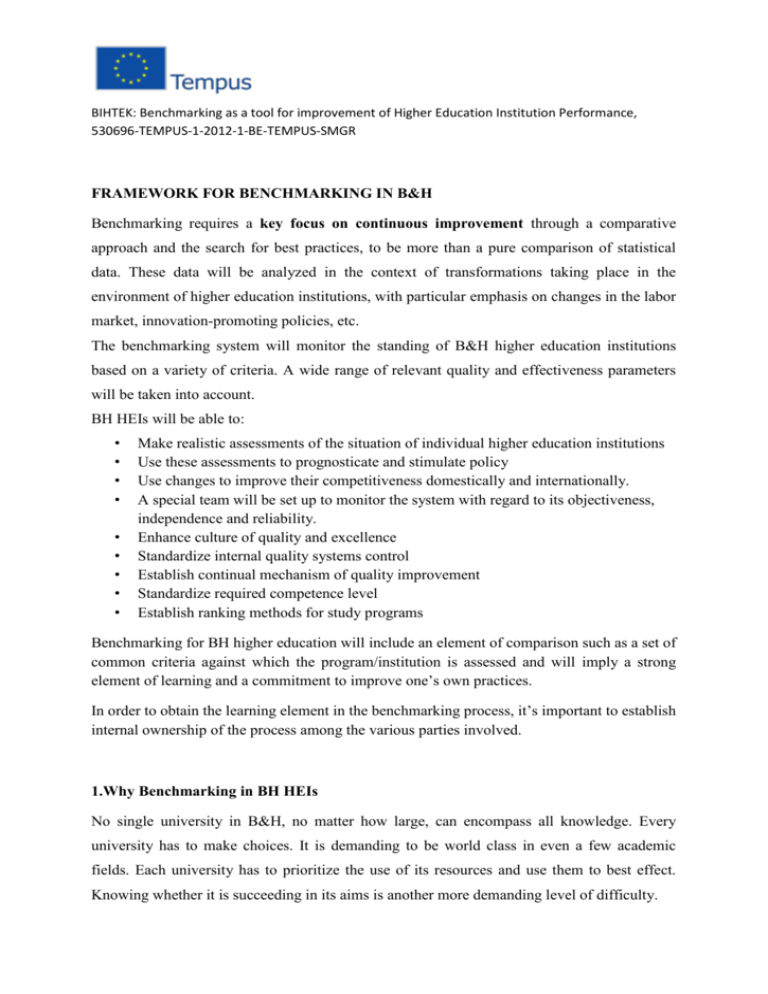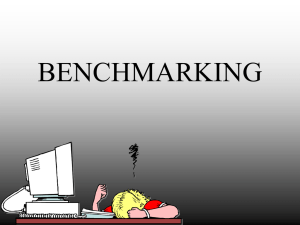Identify Gaps in Performance Identify Best Practice Select
advertisement

BIHTEK: Benchmarking as a tool for improvement of Higher Education Institution Performance, 530696-TEMPUS-1-2012-1-BE-TEMPUS-SMGR FRAMEWORK FOR BENCHMARKING IN B&H Benchmarking requires a key focus on continuous improvement through a comparative approach and the search for best practices, to be more than a pure comparison of statistical data. These data will be analyzed in the context of transformations taking place in the environment of higher education institutions, with particular emphasis on changes in the labor market, innovation-promoting policies, etc. The benchmarking system will monitor the standing of B&H higher education institutions based on a variety of criteria. A wide range of relevant quality and effectiveness parameters will be taken into account. BH HEIs will be able to: • • • • • • • • • Make realistic assessments of the situation of individual higher education institutions Use these assessments to prognosticate and stimulate policy Use changes to improve their competitiveness domestically and internationally. A special team will be set up to monitor the system with regard to its objectiveness, independence and reliability. Enhance culture of quality and excellence Standardize internal quality systems control Establish continual mechanism of quality improvement Standardize required competence level Establish ranking methods for study programs Benchmarking for BH higher education will include an element of comparison such as a set of common criteria against which the program/institution is assessed and will imply a strong element of learning and a commitment to improve one’s own practices. In order to obtain the learning element in the benchmarking process, it’s important to establish internal ownership of the process among the various parties involved. 1.Why Benchmarking in BH HEIs No single university in B&H, no matter how large, can encompass all knowledge. Every university has to make choices. It is demanding to be world class in even a few academic fields. Each university has to prioritize the use of its resources and use them to best effect. Knowing whether it is succeeding in its aims is another more demanding level of difficulty. BIHTEK: Benchmarking as a tool for improvement of Higher Education Institution Performance, 530696-TEMPUS-1-2012-1-BE-TEMPUS-SMGR The key consequential question is how university leaders will know where their institutions stand and how they can be improved. Each university has to prioritize the use of its resources and use them to best effect. Knowing whether it succeeds in its aims is another more demanding level of difficulty. The key consequential question is how university leaders will know where their institutions stand and how they can be improved. Benchmarking is as essential in universities as it is in other spheres. They need reference points for good practice and for ways of improving their functioning. There are a number of reasons why we benchmark: 1. 2. 3. 4. 5. 6. 7. 8. 9. to facilitate improvement process as part of an ongoing continuous improvement mechanisms to ensure that plans are being carried out to focus evaluation on the most useful areas as part of changing management process to justify the existence or value of the service to demonstrate areas of merit to stakeholders to develop relationships/partnerships with other organizations and to assess aspects of management (include the level of management competitiveness) 2. What is Benchmarking Benchmarking is a way of finding and adopting best practices, to the participative 'the open and collaborative evaluation of services and processes with the aim of emulating best available practice, through to the global and ambitious”; benchmarking is the process of continuously comparing and measuring an organization with business leaders anywhere in the world to gain information, which will help the organization take action to improve its performance” Reasons for use of benchmarking in BH HEIs are: • Benchmarking provides qualified, targeted information for strategic decisions through comparison of key performance indicators with strategically relevant partner institutions. BIHTEK: Benchmarking as a tool for improvement of Higher Education Institution Performance, 530696-TEMPUS-1-2012-1-BE-TEMPUS-SMGR • Benchmarking provides standards for institutional quality management/enhancement. • Benchmarking is a means for inter-organizational learning. • Benchmarking can be carried out within a peer-group, on a one-to-one basis or against a database. • Benchmarking brings together the benefits of cooperation and competition. • Benchmarking is an internal governance tool, not an external assessment or ranking. 3. Benefits from benchmarking at BH HEIs • • • • • • • • improved understanding of work flows, processes and procedures continuous improvement in work flows, processes and procedures new ideas leading to continuous improvement and breakthrough change an overview of work flows, procedures and processes in organizations pride in performance participation in decision making breakdown of traditional barriers between branches and management and staff improved productivity 4. Approaches to benchmarking in BH HEIs Benchmarking approach will consists of 5 phases: 1. Planning - Identify the process to be benchmarked (i.e. An institution to be benchmarked and a model institution) - establishment of benchmarking methods 2. Analysis - Establish management commitment to the benchmarking process - Define and understand the process to be benchmarked Identify metrics and collect process data Identify and establish the benchmarking team - establish future performance levels 3. Integration - dissemination of benchmarking results - establishment of functional objectives . BIHTEK: Benchmarking as a tool for improvement of Higher Education Institution Performance, 530696-TEMPUS-1-2012-1-BE-TEMPUS-SMGR 4. Action - development of action plans - implementation of specific actions and progress monitoring - reestablishment of benchmarks 5. Final phase - achieved leadership - practices completely integrated into process Modes of benchmarking process BIHTEK: Benchmarking as a tool for improvement of Higher Education Institution Performance, 530696-TEMPUS-1-2012-1-BE-TEMPUS-SMGR Identify key process Document / Map Sub Processes Identify Critical Success Factors Measure Critical Success Factors Analyze Results; Identify Gaps in Perfor Select Benchmarking Identify Be Conclusion Fundamentally the impact of BH universities is determined by the degree to which it achieves and communicates the quality of its standards, its competitiveness, the quality and importance of its research and the range and quality of its community service. To the degree that it is recognized for these aspects it will have a high reputation and receive adequate recognition for this among stakeholders such as prospective students, parents, employers locally and nationally, and local and national media. The four aspects of external impact that are benchmarked are reputation, competitiveness, academic staff strength, and community service are very important for BH HEI.





